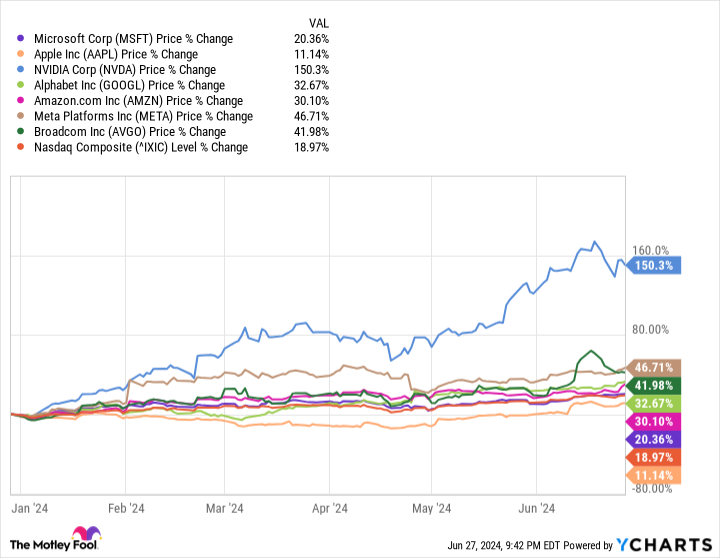This year has been impressive for two of the U.S. stock market’s top three indexes. The S&P 500 is up over 15%, but the Nasdaq Composite is leading the charge, up over 20%.
Following the Nasdaq’s first-half run, investors have been both optimistic and skeptical. Some think the index will continue its run, and others believe it’s due for a pullback at some point this year. Nobody can say for certain how the rest of the year will play out, but you can turn to history to get a bit of perspective.
What has fueled the Nasdaq’s gains this year?
The Nasdaq Composite is an index that tracks the performance of every stock on the Nasdaq stock exchange. Although it contains companies from virtually all major sectors, the tech sector has fueled much of its growth this year. More specifically, its top seven holdings are leading the way.
Using the Fidelity Nasdaq Composite ETF (NASDAQ: ONEQ) as a benchmark, here are the top seven holdings and roughly how much of the index they account for:
-
Microsoft: 11.37%
-
Apple: 10.95%
-
Nvidia: 10.11%
-
Alphabet: 7.39%
-
Amazon: 6.76%
-
Meta Platforms: 3.78%
-
Broadcom: 2.26%
Although the Nasdaq contains over 3,100 companies, it’s highly concentrated in its top holdings. This has worked out in its favor, as those companies (except for Apple) have significantly outpaced the broader market so far in 2024.
When seven companies make up around 52% of an index, and the worst-performing of them is still up by a double-digit percentage for the year, it’s bound to produce good results (albeit with added risk).
What the historical data says about how the Nasdaq might finish 2024
It’s important to stress that trying to predict short-term movements in the stock market is a fool’s game. Nobody — regardless of “expertise” or resources — can accurately forecast how the stock market will perform.
You might think you can, by making rational assumptions, but the stock market itself is notoriously irrational, so that’s never guaranteed. That said, looking at history for insight is never a bad idea as long as you don’t use it to make definitive predictions.
Over the past decade, here are the Nasdaq Composite’s returns through the first half of the year and where it ended to finish the year:
|
Year |
First Half Returns |
End of Year Returns |
|---|---|---|
|
2023 |
32% |
43.4% |
|
2022 |
(29.5%) |
(33.1%) |
|
2021 |
12.5% |
21.4% |
|
2020 |
12.1% |
43.6% |
|
2019 |
20.7% |
35.2% |
|
2018 |
8.8% |
(3.9%) |
|
2017 |
14.1% |
28.2% |
|
2016 |
(3.3%) |
7.5% |
|
2015 |
5.3% |
8.4% |
|
2014 |
5.5% |
15% |
Data source: Macrotrends. Table by author.
In 8 of the last 10 years, the Nasdaq has climbed higher in the back half of the year and finished stronger. That’s encouraging news for investors, especially since many of the top companies leading the index are full of momentum that could carry through the rest of the year and beyond.
How to invest in the Nasdaq Composite
A great way to invest in the Nasdaq Composite is via an exchange-traded fund (ETF), like the Fidelity Nasdaq Composite ETF. Since it mirrors the Nasdaq Composite, you’ll get exposure to the entire index instead of a more concentrated selection of stocks, as you do with the Nasdaq-100.
Although it’s tech-heavy like the Nasdaq-100 (50.58% of the ETF), it covers ground in other sectors as well:
-
Communication services: 15.04%
-
Consumer cyclical: 13.07%
-
Healthcare: 6.79%
-
Industrials: 3.84%
-
Consumer defensive: 3.80%
-
Financial services: 3.54%
-
Basic materials: 1.04%
-
Utilities: 0.89%
-
Real estate: 0.79%
-
Energy: 0.62%
It’s also a relatively cheap option, with a 0.21% expense ratio, or $2.10 per $1,000 invested. It probably shouldn’t be the foundation of your stock portfolio because its lacking in a few sectors, but the ETF can be a valuable addition.
Should you invest $1,000 in Fidelity Commonwealth Trust – Fidelity Nasdaq Composite Index ETF right now?
Before you buy stock in Fidelity Commonwealth Trust – Fidelity Nasdaq Composite Index ETF, consider this:
The Motley Fool Stock Advisor analyst team just identified what they believe are the 10 best stocks for investors to buy now… and Fidelity Commonwealth Trust – Fidelity Nasdaq Composite Index ETF wasn’t one of them. The 10 stocks that made the cut could produce monster returns in the coming years.
Consider when Nvidia made this list on April 15, 2005… if you invested $1,000 at the time of our recommendation, you’d have $751,670!*
Stock Advisor provides investors with an easy-to-follow blueprint for success, including guidance on building a portfolio, regular updates from analysts, and two new stock picks each month. The Stock Advisor service has more than quadrupled the return of S&P 500 since 2002*.
*Stock Advisor returns as of July 2, 2024
Suzanne Frey, an executive at Alphabet, is a member of The Motley Fool’s board of directors. John Mackey, former CEO of Whole Foods Market, an Amazon subsidiary, is a member of The Motley Fool’s board of directors. Randi Zuckerberg, a former director of market development and spokeswoman for Facebook and sister to Meta Platforms CEO Mark Zuckerberg, is a member of The Motley Fool’s board of directors. Stefon Walters has positions in Apple and Microsoft. The Motley Fool has positions in and recommends Alphabet, Amazon, Apple, Meta Platforms, Microsoft, and Nvidia. The Motley Fool recommends Broadcom and recommends the following options: long January 2026 $395 calls on Microsoft and short January 2026 $405 calls on Microsoft. The Motley Fool has a disclosure policy.
The Nasdaq is Up 20% Halfway Through 2024. Here’s What History Says Could Happen in the Second Half. was originally published by The Motley Fool
Signup bonus from





